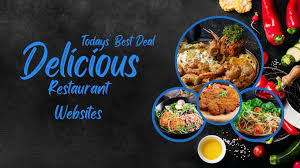
In today’s digital age, having a compelling online presence is essential for any restaurant aiming to attract and retain customers. A restaurant website serves as the digital storefront, offering potential guests their first impression and a crucial touchpoint to engage with your brand. Creating a memorable and effective restaurant website requires more than just listing your menu and contact information—it demands thoughtful design, intuitive functionality, and strategic content that aligns with your restaurant’s identity and goals.
Why a Strong Restaurant Website Matters
Before diving into best practices, it’s important to understand why your restaurant website is so vital. Unlike traditional advertising methods, a website provides 24/7 accessibility and control over your brand’s messaging. It allows you to showcase your cuisine, ambiance, special events, and customer testimonials all in one place. Furthermore, with the rise of online reservations, ordering, and delivery services, your website often acts as the main hub for business transactions.
A well-crafted restaurant website can boost customer trust, improve search engine rankings, increase foot traffic, and elevate customer loyalty. Conversely, a poorly designed or outdated website can drive potential patrons away and diminish your brand reputation.
Best Practices for Building an Effective Restaurant Website
1. Prioritize User-Friendly Design
The design of your restaurant website should be visually appealing, reflecting the style and atmosphere of your establishment. Whether you run a casual café or an upscale dining spot, your website design should align with your brand personality. Use high-quality images of your dishes, interior, and team to create an emotional connection with visitors.
Navigation must be intuitive and straightforward. Visitors should be able to find what they’re looking for—menu, hours, location, or reservation options—within seconds. Avoid clutter and excessive text. Use clear headings and organized sections to guide users smoothly through the site.
2. Optimize for Mobile Devices
More than half of all internet traffic now comes from mobile devices. Your restaurant website must be fully responsive, meaning it adapts seamlessly to smartphones and tablets. A mobile-friendly website ensures that users have a positive experience regardless of the device they’re using, which is especially critical since many potential customers search for restaurants while on the go.
Mobile optimization also plays a significant role in search engine rankings. Google prioritizes mobile-friendly websites, so investing in responsive design improves both usability and visibility.
3. Showcase Your Menu Strategically
Your menu is one of the most important elements on your restaurant website. Present it in an easy-to-read format that is regularly updated to reflect seasonal changes, new dishes, or specials. Consider categorizing the menu into sections such as appetizers, mains, desserts, and beverages for better clarity.
Using appealing descriptions alongside mouth-watering photos can entice visitors to visit your restaurant. Additionally, providing downloadable or printable menu options adds convenience. If your restaurant offers online ordering or delivery, make sure those options are prominently integrated.
4. Integrate Online Reservations and Ordering
Offering online reservations directly through your restaurant website enhances customer convenience and streamlines your booking process. Integrate a reliable reservation system that confirms availability in real-time, reducing the chances of overbooking or miscommunication.
Similarly, if you provide takeout or delivery, incorporate an online ordering platform or link to trusted third-party services. The easier it is for customers to place orders or book tables, the higher your chances of converting website visitors into paying customers.
5. Include Clear Contact Information and Location
One of the most critical functions of a restaurant website is providing visitors with straightforward access to your contact details and location. Display your phone number, email, and physical address prominently, ideally in the header or footer of every page.
Incorporate an interactive map linked to Google Maps or another navigation service to help customers find your location quickly. Including your opening hours and parking or public transport information further assists potential guests planning their visit.
6. Tell Your Story and Highlight Unique Selling Points
People love stories. Use your restaurant website to share the story behind your restaurant—how it started, your culinary philosophy, and what makes your establishment special. This personal touch helps build a connection with your audience and differentiates you from competitors.
Highlight unique selling points such as locally sourced ingredients, chef specialties, dietary accommodations, or eco-friendly practices. Adding a blog or news section can also keep your audience engaged with updates, recipes, events, and promotions.
7. Incorporate Social Proof and Reviews
Customer testimonials and reviews provide social proof that your restaurant is worth visiting. Featuring positive feedback directly on your restaurant website helps build trust with prospective diners.
Link to or embed reviews from trusted platforms such as Google, Yelp, or TripAdvisor. You can also include awards, media mentions, or partnerships that reinforce your restaurant’s credibility and appeal.
8. Focus on SEO and Local Search Optimization
A great restaurant website must be easy to find on search engines. Implementing search engine optimization (SEO) best practices ensures your website ranks higher for relevant queries like “best Italian restaurant near me” or “downtown vegan-friendly restaurant.”
Start with keyword research that includes terms your potential customers are likely to use. Include these keywords naturally in your website’s content, titles, meta descriptions, and image alt texts. Local SEO is especially critical for restaurants; ensure your name, address, and phone number (NAP) are consistent across all online platforms. Register your restaurant with Google My Business to boost local search visibility.
9. Make Loading Speed a Priority
Website loading speed significantly impacts user experience and SEO rankings. Slow-loading pages frustrate visitors and increase bounce rates, meaning users leave your site before engaging with content.
Optimize your restaurant website by compressing images, minimizing unnecessary plugins, and choosing a reliable web hosting provider. Regularly test your site’s speed and address any performance issues promptly.
10. Use Strong Calls to Action (CTAs)
Encourage visitors to take action with clear and compelling CTAs throughout your restaurant website. Whether it’s “Make a Reservation,” “Order Online Now,” “View Our Menu,” or “Join Our Newsletter,” CTAs should stand out visually and be easy to find.
Effective CTAs guide users through the customer journey and help convert casual browsers into loyal patrons.
Conclusion
Creating a memorable online presence for your restaurant hinges on building a restaurant website that is visually appealing, user-friendly, and strategically optimized for engagement and conversions. By prioritizing mobile responsiveness, showcasing your menu creatively, integrating reservation and ordering systems, and focusing on local SEO, your website can become a powerful tool in driving business growth.



